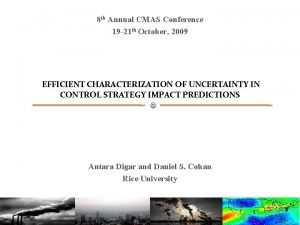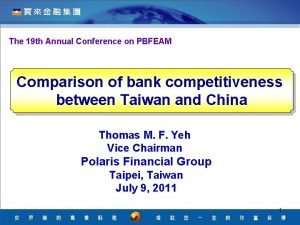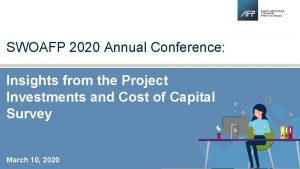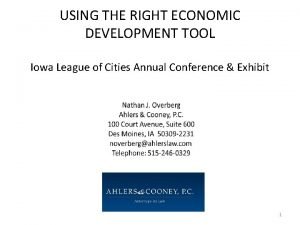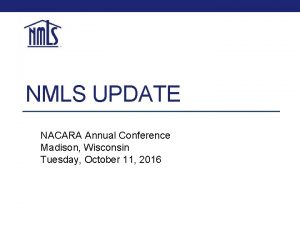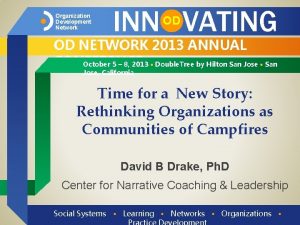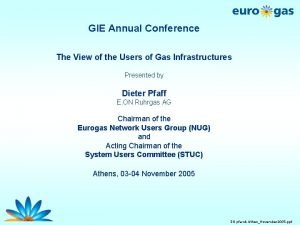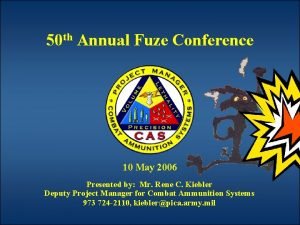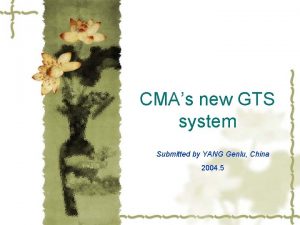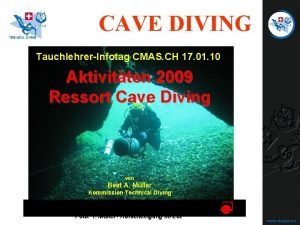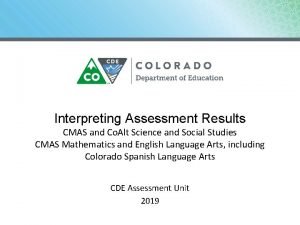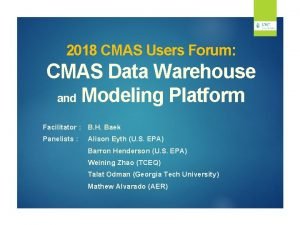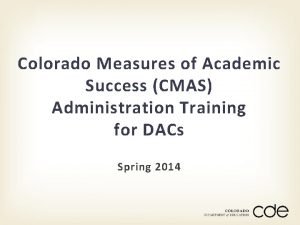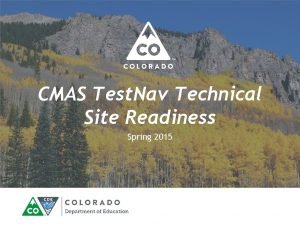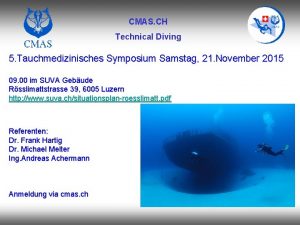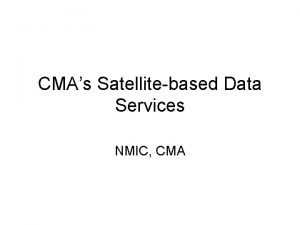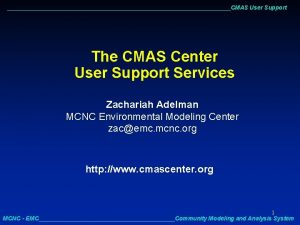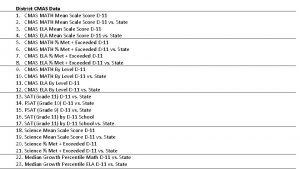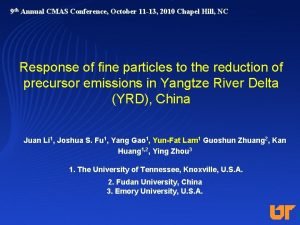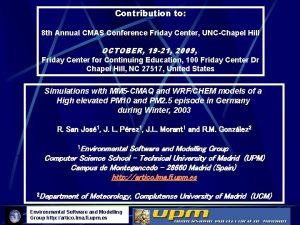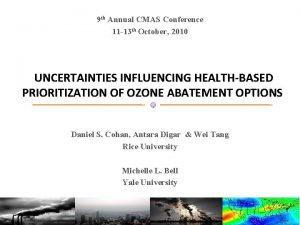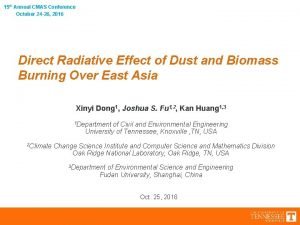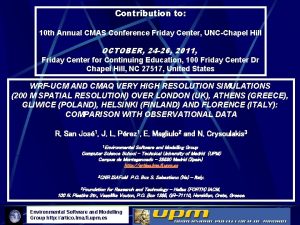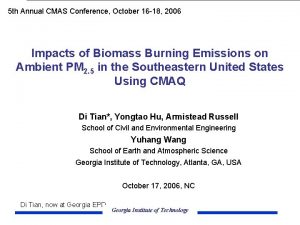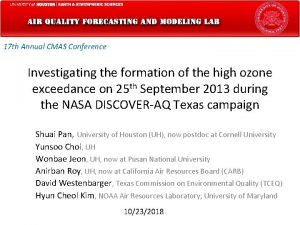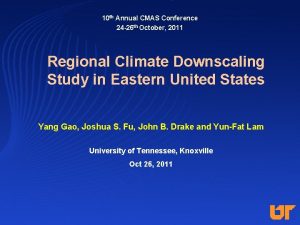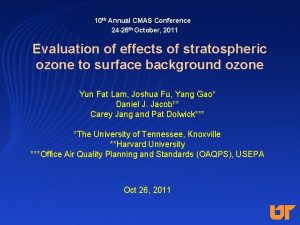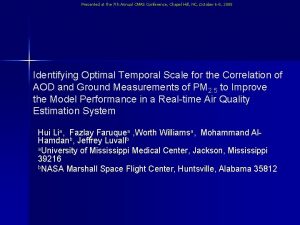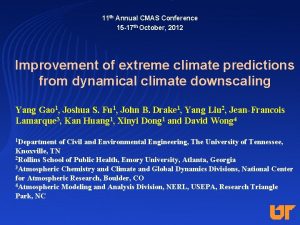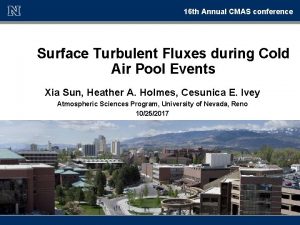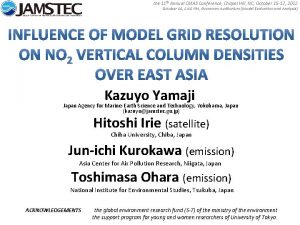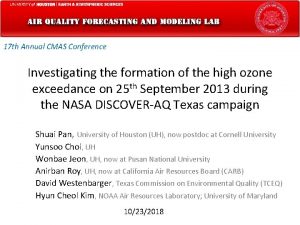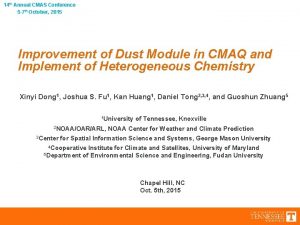17 th Annual CMAS Conference Evaluation of the























- Slides: 23

17 th Annual CMAS Conference Evaluation of the CMAQ Model Performance during Persistent Cold Air Pool Events Xia Sun 1, Heather A. Holmes 1, Kirk R. Baker 2, and Cesunica E. Ivey 3 1. Atmospheric Sciences Program, Department of Physics, University of Nevada, Reno, NV 2. U. S. Environmental Protection Agency, Research Triangle Park, NC 3. Chemical and Environmental Engineering, University of California, Riverside, CA Oct 22 2018, Chapel Hill, NC 1

Persistent Cold Air Pools (PCAPs) Model Challenges § Difficult to replicate the multiday stagnant conditions (Baker et al. 2011) § Complex terrain § Chemistry during PCAPs (Baasandorj et al. § Topographic depression with cold air § During wintertime in mountain areas 2017) 2

Persistent Cold Air Pools (PCAPs) Total number of the occurrences of PCAPs ≥ 3 days during 1979 to 2012 (Yu et al. 2016) 3

The Persistent Cold Air Pool Study (Utah, 2010 -2011, PI: C. David Whiteman) Valley heat deficit: CAPs are accompanied by high PM 2. 5 (Sun et al. 2018, under review) 4

WRF Model Configurations (v 3. 7) § d 01: 12 km, d 02: 4 km § NAM, 12 km, 6 hr reanalysis with 3 hr forecasting dataset § NLCD 40 -class land use § 41 vertical layers § Four Dimensional Data Assimilation 5

WRF Model Configurations § Microphysics: Thompson scheme § Longwave radiation: RRTM § Shortwave radiation: Dudhia § Convective precipitation: Kain-Fritsch 2 Jan 1 -Jan 31, 2011, 7 days segmental run with spin up time of 1 day NAM_ACM 2, NAM_YSU, NAM_MYJ Pleim-Xiu LSM ran extra 10 days for its soil nudging scheme 6

Valley Heat Deficit (H 22) and PBLH H 22 (MJ m-2) Strong PCAPs § Underestimated H 22 § NAM_ACM 2 produced the highest PBLH At the NCAR sounding site (40. 60º N, 111. 93º E) 7

Vertical Profiles (2011/01/02 1700 MST) For this sounding: § WRF did not capture the inversion at 2 km MSL § Overestimated water vapor mixing ratio near the ground § Higher simulated wind in the low levels 8

CMAQ Model Configurations (v 5. 2) § Meteorology: WRF v 3. 7 § Emissions: 2011 National Emission Inventory § Mechanism: cb 6 r 3_ae 6_aq --CB 6, revision 3 gas-phase mechanism --sixth-generation CMAQ aerosol mechanism with sea salt and speciated PM Other --aqueous phase chemistry 9

PM 2. 5 Spatial Variation OBS NAM_YSU NAM_ACM 2 units=µg/m 3 coverage limit=75% NAM_MYJ 10

PM 2. 5 Statistics RMSE - µg/m 3 ME - µg/m 3 >16 12 8 4 0 >24 18 12 6 0 § Higher ME and RMSE in the region impacted by PCAPs (NAM_ACM 2) 11

PM 2. 5 Confusion Matrix NAM_ACM 2 Accuracy (%) = 88. 5 CSI(%) =4. 1 POD(%) =4. 2 FAR(%) =45. 2 NAM_YSU Accuracy (%) = 88. 3 CSI(%) =7. 0 POD(%) =7. 6 FAR(%) =53. 0 NAM_MYJ Accuracy (%) = 88. 5 CSI(%) =6. 2 POD(%) =6. 5 FAR(%) =46. 7 Critical Success Index Probability of Detection False Alarm Ratio 12

Speciated PM 2. 5 (CSN) Large underestimation of NH 4 and NO 313

Time series (Hawthorne site) 24 -hour averages § Daily variation of NOx was well captured § Lower O 3 during CAP pollution episodes 14

Time series (Hawthorne site) 24 -hour averages § Overestimated SO 2 § PM 2. 5 daily trend was captured but underestimated the peaks during strong PCAPs 15

Diurnal Variations-NOx Non-PCAPs § High NOx observed during nighttime § Peak at 4 pm simulated by model 16

Diurnal Variations-O 3 Non-PCAPs § Ozone diurnal variation during non-PCAPs was well simulated. § Overestimation of nighttime ozone during PCAPs might be due to underestimation of NOx or be chemistry related 17

Diurnal Variations-SO 2 Non-PCAPs § Consistent overestimation of SO 2 18

Diurnal Variations-PM 2. 5 Non-PCAPs § Overestimation of PM 2. 5 in the afternoon during non-PCAPs, associated with EC and OC § Underestimated PM 2. 5 at nighttime during PCAPs, associated with underestimated NOx, chemistry, and meteorology uncertainties 19

Diurnal Variations-Speciated PM 2. 5 Non-PCAPs 20

Stacked Plots (Hawthorne site) Non-PCAPs 21

Conclusions § WRF did not capture some of the inversions during PCAPs § CAMQ underestimated PM 2. 5 during PCAPs § NH 4 NO 3 was underestimated and OC was overestimated for speciated PM 2. 5 Simulated and obs avg. daytime surface sensible heat fluxes during Jan 1 to Jan 9 2011 in Salt Lake Valley 22

THANKS! 23
 Cmas conference
Cmas conference 2017 dvhimss annual fall conference
2017 dvhimss annual fall conference Hepi annual conference
Hepi annual conference Pbfeam
Pbfeam Https //bit.ly2v
Https //bit.ly2v Iowa league of cities annual conference
Iowa league of cities annual conference Nmls resource center
Nmls resource center Travel health insurance association annual conference
Travel health insurance association annual conference Organization development network annual conference
Organization development network annual conference Edgar figueroa md mph
Edgar figueroa md mph Gie annual conference
Gie annual conference Gcyf 2011 annual conference
Gcyf 2011 annual conference Problemitize
Problemitize Stfm conference
Stfm conference Fuze conference 2018
Fuze conference 2018 Mfc cmas
Mfc cmas Cmas.ch
Cmas.ch Cmas score range
Cmas score range What is com.lge.cmas
What is com.lge.cmas Cmas forum
Cmas forum Colorado measures of academic success
Colorado measures of academic success Cmas
Cmas Cmas test nav
Cmas test nav Cmas ch
Cmas ch
